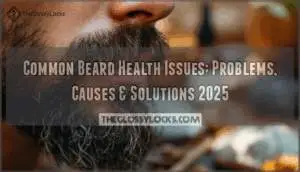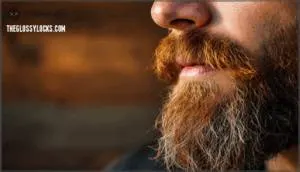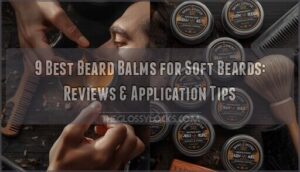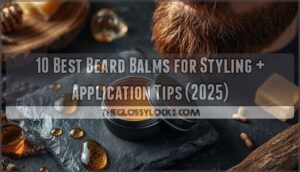This site is supported by our readers. We may earn a commission, at no cost to you, if you purchase through links.
 Your beard isn’t just facial hair—it’s a living ecosystem that can host fungi, bacteria, and skin conditions you’d never see coming. Most men ignore the warning signs until persistent itching, flaking, or patchy bald spots force them to confront what’s happening beneath those whiskers.
Your beard isn’t just facial hair—it’s a living ecosystem that can host fungi, bacteria, and skin conditions you’d never see coming. Most men ignore the warning signs until persistent itching, flaking, or patchy bald spots force them to confront what’s happening beneath those whiskers.
The good news? Nearly every common beard health issue has a proven fix once you understand what’s actually causing the problem. From ingrown hairs that burrow under your skin to hidden folliculitis infections that can spread, this guide breaks down the most frequent beard disasters and the clinical solutions that work.
Table Of Contents
Key Takeaways
- Most beard problems—from persistent itching and dandruff to painful ingrown hairs and hidden infections—stem from harsh products, poor hygiene, and improper grooming techniques that you can fix with targeted solutions.
- Your beard creates a blind spot where serious conditions like folliculitis, fungal infections, and even skin cancers can develop undetected, making regular self-exams and proper maintenance essential for preventing complications.
- Daily beard care requires a strategic routine: wash 2-3 times weekly with dedicated beard cleanser, apply oil to damp hair for deep hydration, exfoliate weekly to clear blocked follicles, and use sharp tools with proper technique to prevent razor bumps and ingrown hairs.
- Persistent symptoms like sudden bald patches, chronic infections, or unresponsive skin conditions demand professional help immediately—conditions like alopecia barbae and severe folliculitis won’t resolve with home remedies and need dermatologist intervention.
Most Common Beard Health Problems
Your beard can turn from impressive to irritating fast when common health problems show up. These issues range from minor annoyances like itching to serious concerns that need professional attention.
Let’s break down the seven problems you’re most likely to face.
Itching and Discomfort
That maddening itch beneath your beard isn’t just annoying—it’s your skin waving a red flag. Persistent itching and discomfort signal that something’s off beneath the surface. Dry skin, trapped debris, or harsh products create irritation causes you can’t ignore.
Your beard itchiness demands itch relief—not scratching that makes things worse. Beard soothing starts with skin calming techniques and proper discomfort solutions that address the root problem.
Beard Dandruff and Flaking
White flakes on your collar aren’t snowfall—they’re beard dandruff, and they reveal what’s happening on the skin underneath your facial hair. Flaky skin and beardruff strike when Malassezia yeast overgrows or your dry beard traps dead cells.
Dandruff causes include:
- Yeast overgrowth triggering inflammation and beard itch
- Product buildup clogging follicles and creating flaky dandruff
- Inadequate cleansing leaving debris behind
Flaking prevention requires beard exfoliation and targeted scalp treatment to restore control.
Patchy Growth and Bald Spots
Bald patches in your beard expose gaps your grooming routine can’t fix alone. Patchy beard growth stems from genetic factors, hormone balance issues, or autoimmune attacks like alopecia barbae that target follicle health. Age distribution matters—younger men often see incomplete coverage as dormant follicles awaken slowly, while sudden bald patches after 30 demand investigation. Regional variation shows testosterone-sensitive zones filling unevenly. Hair loss patterns reveal whether you’re fighting genetics, blocked follicles, or immune dysfunction. Understanding your unique facial hair growth is essential to addressing patchy beard issues.
| Cause | Mechanism | Timeline |
|---|---|---|
| Genetic Factors | Follicle sensitivity varies | Years to develop |
| Alopecia Barbae | Immune attack on follicles | Weeks to months |
| Hormone Balance | Testosterone/DHT fluctuation | Ongoing cycles |
| Blocked Follicles | Product/skin buildup | Days to weeks |
Redness and Skin Irritation
Your skin beneath the beard takes the brunt of friction, trapped sweat, and product residue—and when inflammation sets in, redness spreads fast. Skin irritation erupts when harsh chemicals strip protective barriers, leaving you vulnerable to irritant reactions. Sensitive skin amplifies the response—your follicles trap allergens while poor skin hygiene feeds bacterial overgrowth.
- Redness causes include contact dermatitis from fragrances, preservatives, or alcohol-based products
- Mechanical friction from rough towels or aggressive brushing triggers inflammatory pathways
- Trapped moisture creates ideal conditions for yeast and bacterial colonization
- Inflammation treatment requires identifying triggers and switching to fragrance-free, non-comedogenic formulations
Ingrown Hairs and Razor Bumps
Curved hairs pierce back into your skin when improper shaving angles or follicle obstruction redirect growth inward instead of outward. Razor bumps form when your immune system attacks these trapped hairs—resulting in raised, inflamed papules that mimic acne.
Shaving techniques matter: dull blades create ragged cuts that curl under skin, while shaving against the grain forces hairs below the surface.
Exfoliation methods clear dead cells blocking follicles, but bump prevention demands pre-shave prep and sharp, single-pass strokes to minimize trauma.
Folliculitis and Infections
Bacterial infections can turn minor follicle damage into painful, pus-filled eruptions that spread quickly without proper beard hygiene. Staphylococcus aureus is the culprit in most cases, affecting up to 83% of Black men who shave regularly. Fungi like Malassezia can also trigger itchy papules that resemble acne.
- Staph infections form skin abscesses when bacteria colonize damaged follicles
- Fungal folliculitis presents as uniform, itchy bumps resistant to antibacterial treatments
- Infection control requires chlorhexidine washes and single-blade razors
- Ingrown hairs compound risk by creating entry points for pathogens
Proper management of follicle health issues is essential to prevent complications and promote healthy beard growth.
Hidden Skin Cancers
Melanoma and basal cell carcinoma can lurk undetected beneath dense facial hair, making beard screening essential for skin cancer risks prevention. Your beard creates a blind spot where dermatological conditions develop silently—hidden melanoma often goes unnoticed until late stages.
Regular facial skin checks require parting your beard to examine skin health thoroughly. Look for new moles, irregular borders, color changes, or persistent sores that don’t heal.
Proper skin hygiene and health routines include monthly self-exams and annual dermatologist visits for thorough skin cancer prevention tips.
Causes of Poor Beard Health
Your beard problems don’t happen by accident. Several culprits work against your facial hair, from what you put on it to how you treat it daily.
Here’s what’s sabotaging your beard health and why it matters.
Harsh Products and Chemical Exposure
Most beard products on the market are loaded with sulfates, parabens, and synthetic fragrances that strip your facial hair of its natural oils and wreak havoc on the skin underneath. These toxic ingredients trigger chemical reactions that cause beard itchiness, skin irritation, and beard acne.
You’re basically putting harsh chemicals on your face daily, leading to product allergies and skin sensitivity. Some guys even experience chemical burns from repeated exposure to these skin conditions.
Inadequate Beard Hygiene
Your beard is a magnet for bacteria, dead skin, and food particles—and if you’re not washing it regularly, you’re creating a breeding ground for infection and inflammation. Skipping a proper beard wash routine lets oil and dirt clog your hair follicles, triggering beard itch and skin conditions that poor grooming habits make worse.
Here’s what happens when you neglect facial hair care:
- Dead skin cells accumulate, blocking follicles and causing beard dandruff
- Bacteria multiply rapidly, leading to folliculitis and acne breakouts
- Food debris and environmental pollutants create a disgusting mess
- Your beard oil application becomes useless without clean facial hair and proper skin exfoliation first
Improper Grooming Techniques
If you’re hacking away at your beard with dull scissors or attacking your face like you’re clearing brush, you’re doing more damage than you realize. Poor grooming habits like aggressive beard trimming without proper skin preparation cause razor burn and follicle damage that sabotages your entire beard care routine.
| Wrong Technique | What It Does to You |
|---|---|
| Dry trimming without wash | Tears hair shafts, creates split ends |
| Dull grooming tools | Pulls follicles, causes ingrown hairs |
| Shaving against grain | Triggers razor burn and inflammation |
| No pre-shave prep | Strips protective oils, irritates skin |
| Over-trimming weekly | Weakens follicles, slows beard maintenance |
Master proper shaving technique and beard care routine basics—or keep suffering the consequences of sloppy grooming techniques.
Environmental and Lifestyle Factors
Sun, wind, and stress wreck your beard just as fast as bad grooming—and most guys never connect the dots between their lifestyle and their failing facial hair. Air pollution clogs follicles, while poor water quality strips natural oils during your beard care routine.
Your diet impact shows up in brittle strands, and stress effects trigger patchy growth faster than any grooming techniques mistake.
Climate influence matters too—dry air demands stronger beard maintenance and smarter facial hair care strategies.
Genetic and Autoimmune Conditions
Sometimes the real culprit isn’t what you’re doing to your beard—it’s what your body’s doing to itself. Heredity accounts for roughly 80% of male pattern baldness risk, while autoimmune disorders like alopecia barbae turn your immune system against hair follicles.
Your beard problems aren’t always your fault—80% of male pattern baldness is genetic, and autoimmune disorders can turn your immune system against your own follicles
By age 50, half of all men face androgenic hair loss, and patchy bald spots often signal T-cells attacking beard health at the root.
Genetic testing and targeted alopecia treatment can help restore hair follicle health and kickstart beard regrowth.
Essential Beard Care and Maintenance Tips
You can’t beat beard problems by wishing them away. You need a solid maintenance routine that works with your skin and hair, not against it.
Here’s what actually keeps your beard healthy and looking sharp.
Daily Cleansing and Beard Wash Routine
Washing your beard properly isn’t just about splashing water on your face and calling it a day. You need lukewarm water and a dedicated beard wash—not regular shampoo—2-3 times weekly to break down oil, bacteria, and dead skin cells without stripping natural moisture.
Your daily cleansing routine:
- Use gentle, circular motions to massage beard wash into both hair and underlying skin
- Rinse thoroughly with lukewarm water to prevent product buildup and irritation
- Pat dry with a clean towel—never rub aggressively, which damages follicles
Proper Application of Beard Oils and Balms
Once your beard is clean, the real key is locking in moisture with the right oil or balm—but most guys mess up the timing and technique.
Apply beard oil immediately after washing while your beard’s still slightly damp—this traps hydration at the follicle level. Warm 3-4 drops between your palms, massage directly into the skin beneath, then work outward through the hair.
Beard balm comes next for grip and extra protection.
Regular Trimming and Shaping
Most guys skip the shears thinking growth alone builds a great beard, but regular trimming every 2-3 weeks actually accelerates healthy development by cutting off split ends before they travel up the shaft.
Use quality trimming tools—sharp scissors or clippers—to maintain beard symmetry and facial harmony.
Shaping techniques depend on your hair texture, so adapt your approach accordingly.
Weekly Exfoliation for Skin Health
Dead skin cells pile up beneath your beard like dust under a rug, choking follicles and triggering irritation if you don’t scrub them away weekly. Use gentle scrubbing with exfoliation techniques designed for facial skin—not harsh body scrubs—to boost skin renewal without damage.
Massage your cleanser in circular motions to lift debris, improve circulation, and support healthy skin conditions underneath your beard.
Choosing High-Quality Beard Products
Your beard products either feed your facial hair or sabotage it—there’s no middle ground. Choose natural formulas with proven ingredients like jojoba, argan, or castor oil for real beard oil benefits. Skip synthetic fragrances and filler chemicals that strip moisture.
Compare brands carefully—quality beard care means nourishing skin beneath your beard, not just coating the surface.
Preventing and Solving Common Beard Issues
You don’t have to live with a rough, patchy, or irritated beard. Most common problems have straightforward fixes once you know what you’re dealing with.
Here’s how to tackle the issues that keep your beard from looking and feeling its best.
Managing Dryness and Itchiness
Dry, itchy beard hair isn’t just annoying—it’s your skin crying out for moisture and proper care. Relieving beard itchiness starts with consistent hydrating of your dry beard and the skin underneath.
Crush beard itch and dry skin with these hydration tactics:
- Wash smart: Use lukewarm water and beard-specific cleanser 2-3 times weekly
- Oil up daily: Apply beard oil to damp hair, massaging into skin for deep beard hydration
- Lock in moisture: Follow with beard balm or butter for extra skin soothing
- Brush it out: Distribute natural oils and boost beard moisture with a boar bristle brush
- Hydrate inside: Drink plenty of water—your skin needs it from within
Preventing Ingrown Hairs and Bumps
Ingrown hairs turn your face into a minefield of painful, inflamed bumps that won’t quit until you change how you treat your skin.
Prevent ingrown hairs and razor burn by mastering exfoliation techniques—scrub 2-3 times weekly to clear dead cells blocking follicles. Use noncomedogenic products that won’t trap beard acne-causing bacteria.
Switch your shaving methods: shave with the grain, use sharp blades, and apply warm compresses before grooming for bump prevention that actually works.
Addressing Patchy or Thin Beards
Patchy beard growth isn’t a life sentence—hair follicles develop at different rates, leaving thin beard areas that fill in over time with proper beard care.
Weekly exfoliation removes dead cells blocking follicles, while beard oils boost beard density by nourishing patchy areas.
Stop waiting for miracles—focus on improving beard health through consistent grooming that aids natural hair growth patterns.
Treating Beard Acne and Breakouts
Facial hair traps oil, dead skin, and bacteria against your skin—around 50 million Americans deal with acne, and your beard can make breakouts worse if you’re not washing it right.
Wash your face twice daily with a gentle cleanser to strip away trapped debris causing beard acne. Topical medications target stubborn breakouts, while weekly skin exfoliation methods prevent ingrown hairs and clear blocked pores.
Chronic acne treatment options include seeing a dermatologist who’ll prescribe stronger solutions when basic beard care routines fail.
Solutions for Frizz and Dullness
Dehydration and harsh chemicals leave facial hair looking like a wire brush—but the right products and techniques can restore softness and shine in just a few days.
Apply beard oil remedies twice daily to lock in moisture and tame frizz. Weekly deep conditioning treatments boost shine enhancement, while proper hair moisturizing prevents that straw-like texture from returning.
When to Seek Professional Help
Sometimes your beard won’t respond to home remedies, and that’s when you need to bring in the experts. Knowing when to stop DIY solutions and get professional guidance can save you months of frustration and prevent serious problems from getting worse.
Here’s what signals it’s time to book that appointment.
Persistent Skin Problems or Infections
When your skin keeps flaring up or an infection won’t quit, it’s time to stop guessing and get real help. Folliculitis treatment and skin infection management need expert eyes.
If you’re dealing with a beard abscess, chronic ingrown hairs, fungal infections, or stubborn beard acne that won’t back down, see a dermatologist. Don’t let persistent redness and irritation wreck your face.
Sudden Hair Loss or Bald Spots
Losing patches of beard hair overnight isn’t just frustrating—it’s a red flag that demands immediate attention. Alopecia barbae causes sudden bald patches that won’t fix themselves.
Autoimmune factors attack your hair growth cycle, and androgenic hair loss patterns need proper diagnosis.
Don’t wait—alopecia treatment and beard restoration options work best when you catch hair loss early. Get professional help now.
Chronic Beard Dandruff or Redness
Flakes snowing from your beard every time you scratch, paired with angry red skin underneath, means something’s seriously wrong with your grooming routine or skin health. Fungal infections like Malassezia cause persistent flaky dandruff and beard inflammation that won’t respond to basic redness remedies.
Scalp conditions creating chronic beard itch, irritation, and redness need professional diagnosis—dandruff causes vary, and you can’t fix what you can’t identify.
Considering Dermatologist or Barber Advice
Sometimes the mirror tells you one thing, but your skin is screaming something else—and that’s exactly when you need to stop playing dermatologist and actually call one. Professional Guidance cuts through guesswork:
- Dermatologists diagnose Skin Conditions and Diseases causing chronic Beard Health problems through Skin Analysis
- Beard Consultations identify underlying issues like folliculitis or autoimmune disorders
- Barbers master Grooming Techniques for Facial Hair Care and Maintenance preventing damage
- Specialists offer Beard Care and Maintenance strategies or Hair Restoration options when self-care fails
Advanced Solutions Like Beard Transplants
Beard Restoration through beard transplantation offers a permanent solution when alopecia barbae or severe hair loss leaves you with persistent gaps. Surgeons relocate hair follicles from donor areas—usually your scalp—using Grafting Techniques like FUE or FUT.
Transplant Costs range from $3,000 to $15,000 depending on coverage area.
Surgery Risks include scarring, infection, and unnatural growth patterns, so thoroughly vet your provider before committing to Facial Hair restoration.
Frequently Asked Questions (FAQs)
Can beard health affect overall facial appearance?
Yes, absolutely. Your beard’s condition directly shapes how others perceive your face. A well-maintained beard improves facial symmetry and complements your facial structure.
But patchy beard growth, poor skin texture, or beard itchiness signal neglect—undermining your entire look and confidence.
How does diet impact beard growth quality?
Your protein sources, vitamin balance, and mineral intake directly fuel hair follicles. Nutrient deficiency slows facial hair growth, while proper hydration levels and beard care routines strengthen beard health from the inside out.
What role does sleep play in beard health?
You need adequate rest for peak beard health. Sleep regulates hormone balance, particularly testosterone and growth hormones, which directly influence hair follicles and beard growth rates.
Poor rest quality disrupts this process, potentially causing hair loss.
Are there seasonal beard care adjustments needed?
Winter cold strips moisture from your beard faster than summer heat ever could. Seasonal Beard Changes demand smart adjustments—boost Beard Moisture with heavier oils during winter, switch to lighter formulas when Humidity Control matters in summer, and always match Temperature Adjustments to protect your beard health through every season.
How often should beard tools be cleaned?
Clean your tools after every use with alcohol or antibacterial spray. Bacterial growth happens fast, so daily sanitizing isn’t optional—it’s essential for beard health and hygiene.
Deep-clean brushes and combs weekly using warm water and gentle soap.
Conclusion
Don’t let your beard become a breeding ground for disaster. You’ve seen how common beard health issues can escalate from minor irritation to serious infections when left unchecked.
The difference between a beard that thrives and one that betrays you comes down to consistent care and recognizing warning signs early. Clean it properly, choose quality products, and never ignore persistent symptoms.
Your face deserves better than neglect.
- https://teens.webmd.com/boys/rm-quiz-teen-guys-puberty-iq
- https://jddonline.com/articles/shave-frequency-and-regimen-variation-effects-on-the-management-of-pseudofolliculitis-barbae-S1545961613P0410X
- https://pmc.ncbi.nlm.nih.gov/articles/PMC6585396/
- https://dermnetnz.org/topics/folliculitis-barbae
- https://www.vinmec.com/eng/blog/recurrent-folliculitis-what-to-do-en











